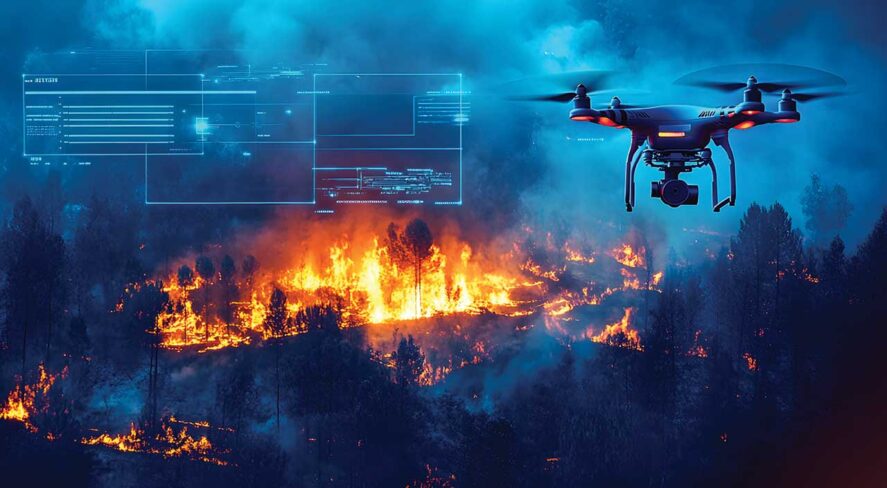The Convergence of Vision, Intelligence and Agency

AI is reshaping physical security and humans’ role in it

For years, the promise of artificial intelligence (AI) has been quietly reshaping the digital world. Now, that influence is moving beyond the screen and into the physical spaces where we work, shop and live. This shift from bits to atoms is nowhere more apparent than in physical security, an industry on the cusp of its most significant transformation in a generation.
The days of reactive, forensic security are numbered. Today, AI is enabling a proactive, predictive posture that reshapes how organizations protect their people, property and infrastructure. At the heart of this evolution is computer vision, AI’s ability to interpret and act on visual data in real time. This is not just about better automation; it is a fundamental convergence of physical security, cybersecurity and business intelligence. We are moving toward fully integrated threat detection and response ecosystems, and the implications for technology and talent are immense.
Three Forces Driving the Shift
The move from AI experimentation to enterprise-scale deployment is not happening in a vacuum. It is the result of three powerful, converging trends.
1. The Rise of Multimodal AI
The most advanced AI systems no longer operate on a single data stream. Multimodal AI fuses visual data from cameras with audio, text access control logs, and network data. This creates a rich, contextual understanding of the environment, allowing the system to make dynamic, real-time decisions. Think of it as moving from a single-sense understanding of a situation to a full-sensory one, dramatically reducing false positives and identifying complex threats that would otherwise go unnoticed.
2. The Mandate for AI Governance
As AI becomes more powerful, the need for guardrails grows. Regulatory frameworks like the European Union’s AI Act and recent presidential executive orders in the United States are pushing organizations toward transparency, ethical deployment, and risk mitigation. This is not a barrier to innovation; it is a catalyst for trust. For enterprise security leaders, a strong governance framework is essential for adopting AI responsibly and ensuring that its outputs are fair, reliable and auditable.
3. The Autonomy of Edge AI
Not all decisions need to travel to the cloud and back. The proliferation of powerful processors allows for edge AI, where smart sensors, drones and robotic patrol units can make localized decisions instantly. This reduces latency, improves resilience (especially in low-connectivity areas), and ensures that critical alerts are processed on-site, enabling a faster, more effective response without cloud dependency.
AI-Enabled Capabilities
This convergence of technological forces is creating a new suite of tools that are redefining the capabilities of modern security programs.
- Proactive surveillance through vision AI: This is the foundational layer. Computer vision transforms surveillance cameras from passive recording devices into active, always-on sentinels. Instead of a human operator trying to monitor dozens of screens, the AI platform intelligently detects potential threats, such as unauthorized access, suspicious loitering, tampering or brandishing of weapons, and triggers immediate, targeted alerts. This allows security teams to focus on the signal, not the noise, and to intervene before an incident escalates.
- Autonomous aerial and ground units: AI-powered drones and robotic patrol pods are becoming powerful force multipliers. Equipped with thermal and advanced vision analytics, these units can conduct automated patrols of large perimeters, track threats in real time, and inspect hazardous environments, all while reducing the risk to human personnel. Integrated with a central AI platform, they provide an on-demand “eye in the sky” or a persistent ground presence that extends the reach of the security team.
- Unified decision intelligence of the GSOC: The global security operations center (GSOC) is evolving from a monitoring hub into an intelligence nerve center. Next-generation GSOCs are powered by AI platforms that integrate vision, access control, communications and even cyber threat data into a single pane of glass. This provides operators with predictive situational awareness, allowing them to take action on a suspicious physical event and a potential digital attack vector, enabling a truly unified response.
Cyber-Physical Convergence: From Security to Intelligence Operations
The most damaging and costly breaches often start with a simple physical lapse: a tailgater slipping through a door, a sensitive document left on a printer, an unauthorized device connected to a port. For too long, physical security and cybersecurity have operated in silos. This is no longer a viable strategy.
These events are not isolated risks; they are entry points to systemic compromise.
AI—computer vision, in particular—is the bridge that finally connects the two domains. It allows organizations to achieve true cyber-physical threat correlation. For example, an AI platform can:
- Flag an access control event where one person’s badge is used, but the camera feed shows a different person (or multiple people) entering
- Detect an individual accessing a server room after hours and correlate it with anomalous network activity originating from that same location
- Identify reconnaissance behavior, such as someone taking photos of secure areas or attempting to access restricted zones repeatedly
This marks a profound shift in thinking, from running separate security operations to managing a unified intelligence operation, where all data converges to create a complete picture of the threat landscape.
The Human Factor: Augmenting Talent, Not Replacing It
Perhaps the most critical aspect of this transformation is its impact on people. The narrative of AI replacing jobs is outdated and incomplete. In physical security, AI is augmenting human talent, offloading repetitive, low-value tasks and elevating human operators into more strategic roles.
Frontline staff can now shift from being passive monitors to becoming vision system operators, cyber-physical threat analysts, and human-robot interaction specialists. This evolution requires a new focus on reskilling and a framework for managing the partnership between people and machines.
To guide this transition, leading organizations are adopting the Human Agency Scale (HAS), a framework for determining the appropriate level of human involvement for any given AI-enabled task.
The HAS framework shifts the question from “Can we automate this?” to “Should we automate this, and to what degree?” It ensures that human judgment, intuition and context awareness remain central to the security mission, fostering trust and preventing the blind spots that can arise from over-automation.
Funding Intelligence Through Risk Avoidance
Ultimately, the adoption of a vision-driven security strategy is a business decision. With the average cost of a cyber breach now at $4.8 million, a proactive investment in an AI-powered physical security platform, which can prevent the incidents that lead to such breaches, offers an undeniable return on investment.
Security is no longer a cost center; it is a business intelligence function that avoids catastrophic losses, protects brand reputation and optimizes operational uptime. By building a strategic roadmap that invests in human-AI collaboration, establishes strong AI governance and engineers safe human-robot workspaces, organizations can unlock immense value.
Vision Is the Interface, Human Agency Is the Compass
The future of security is here, and it is powered by computer vision. But technology alone is not the answer. Vision AI is the catalyst that enables us to see more and react faster, but it is human agency that provides the guidance to implement it responsibly and effectively.
Organizations that embrace this new paradigm, treating AI not as a replacement for people, but as a tool to elevate human judgment, will lead the way. They will move beyond the old model of “react and record” to a future of “predict and prevent,” one powered by the unmatched combination of artificial intelligence and human wisdom.
